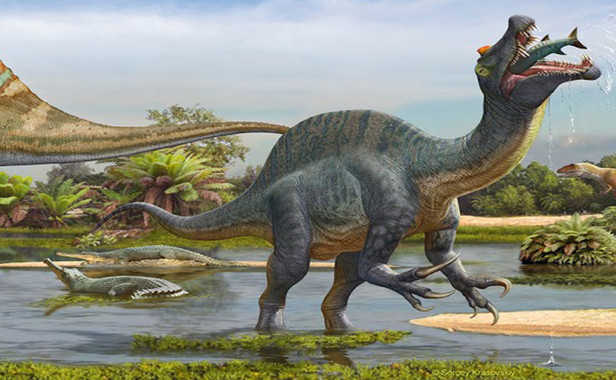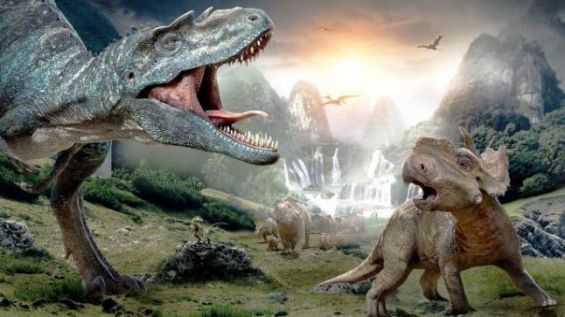Millions of years ago, dinosaurs lived on our planet and scientists and paleontologists have managed to provide the world with glimpses of their lives and features. While exploring the age of the dinosaurs, they discovered that many of these weirdly-shaped creatures lived, preyed and roamed Morocco.
Dinosaur fossils found in Morocco helped researchers answer questions about the prehistoric era. According to several studies, the Kingdom has even been a rich fauna of dinosaurs during several periods.
To those who are curious enough to discover more about these gigantic and prehistoric animals we have a list for you. Four bizarre-looking reptiles inhabited the country. Thanks to science, we now know that some of them could swim, while others could fly or lived shortly before the mass extinction.
Spinosaurus, Kem Kem’s swimming dinosaur
It is a theropod, a very big one also, but most precisely one that could swim. North Africa was the primary home of this dinosaur, discovered for the first time in Egypt in 1912. Spinosaurus, which, according to scientists, lived during the Cretaceous period, was also found in Morocco.
The first discovery was linked to the Kem Kem beds, a geological formation located near the border between Morocco and Algeria. The area was described by Luke Mahler, from the department of Anatomy and the Organizational Biology at the University of Chicago, as an area that «have produced a disproportionally large number of carnivores (…) including Spinosaurus».

The fossils of this theropod, who is also called Spinosaurus maroccanus, revealed that he is one of the largest carnivorous dinosaurs, who preyed mostly in the water and had round or crescent-like dorsal sails.
In 2014, more details were given about this gigantic carnivore. The findings of a study, carried by German-Moroccan paleontologist Nizar Ibrahim, brought evidence suggesting that this dinosaur could swim.
In a study published on Science, the paleontologist concluded that Spinosaurus is «the world’s first known swimming dinosaur». Ibrahim described it as a 15-meter-long «behemoth» that has a crocodile-like face and is perfectly equipped to swim.
«It’s the first dinosaur that shows these really incredible adaptations», Nizar Ibrahim told science journal Nature. «There’s no doubt in my mind that Spinosaurus would have done most of its hunting in the water».
Relying on already-found fossils and remains found in Erfoud, Ibrahim managed to get a more detailed picture of Morocco’s Spinosaurus. According to Nature, the semi-aquatic creature has «nostrils that are located relatively high on its skull, perhaps so that it could breathe while partly submerged». Its teeth, on the other hand, «are interlocked like a fish trap, and its powerful forelimbs could have paddled through the water».

Although this giant dinosaur could swim, further research found out that he was an «awkward swimmer». Quoting a 2018 study published on PeerJ, National Geographic reported about the Moroccan monster that «despite its taste for fish, he may not have been a great swimmer after all». The study compared the animal to nowadays' crocodiles, who spend a lot of time in the water but are awkward swimmers.
Morocco’s long-necked herbivore
It is a long-necked and small-headed dinosaur who lived in both Africa and Europe. Its fossils were discovered decades ago, suggesting that unlike other dinosaurs that inhabited Morocco, it was a plant-eating sauropod.
The first described Cetiosaurus was found in England in 1841. It was first labeled as a «whale reptile» that was «about the same size as the North Atlantic great whales», according to a platform called HowStuffWorks.

But there is more to this dinosaur than just that. Three skeletons of the reptile were found in 1960 in El Mers, a small town in the Fes-Meknes region by French paleontologist Albert-Félix de Lapparent. The scientists called the dinosaur Cetiosaurus mogrebiensis, referring to Morocco.
The big monster who lived during the Middle Jurassic Period roamed only terrestrial habitat and reproduced by laying eggs, according to the platform Dinosaur Pictures.
Morocco's flying reptile and dinosaurs' cousin
Technically speaking, it is just a reptile that could fly, but it is mostly referred to by media as the «flying dinosaur». Pterosaur is literally a winged lizard, who flew over Morocco 66 million years ago. It is known by its powerful wings, long tail and fully-toothed jaws.
According to a 2010 survey, Pterosaur fossils were mainly discovered in the Kem Kem beds. «The Hamada Kem Kem and Maider region» are described as the «principal pterosaur localities» in the Kingdom, researchers revealed.
However, researchers debated over when and how these animals went extinct. According to a 2018 study, Pterosaurs, who are known as the cousins of dinosaurs, were stronger and more diverse by the end of the Cretaceous period than what scientists previously thought.

Researchers from the Bath and Portsmouth universities in England found that the bones discovered in Morocco belong to different and distinct types of the flying reptiles.
Based on previous findings, scientists believed in the past that these species were going extinct way before the end of the dinosaurs era, which occurred 66 million years ago. However, the new study conducted by the two universities and made public by journal PLOS Biology suggested that the fossils found in the Kingdom belonged to the Cretaceous period.
«To be able to grow so large and still be able to fly, pterosaurs evolved incredibly lightweight skeletons, with the bones reduced to thin-walled, hollow tubes like the frame a carbon-fiber racing bike», the study revealed. The latter concluded that these Moroccan reptiles belong to the latest species of their kind that lived on Earth during the last phase of the Cretaceous period.
Chenanisaurus, Morocco and Africa’s last dinosaur
It is an Ouled Abdoun Basin-native and Africa’s last dinosaur. Chenanisaurus, who lived in Morocco, is a smaller version of America’s T-rex. This dinosaur is known for its tiny arms, big head and separate teeth.
In 2017, researchers found that the predatory abelisaurid theropod is one of the latest dinosaurs that lived in Morocco, 66 million years ago. The discovery was described as similar to winning the lottery by Doctor Nick Longrich who studied a partial jaw belonging to the predator.

Found in a phosphate mine, the dinosaur is a two-legged Abelisaur measuring 7-8 meters (23-26 ft). While examining the discovery, Longrich indicated that its teeth were strong enough to crack a bone.
«It’s one of the last dinosaurs in Africa before the mass extinction that wiped out the dinosaurs. It’s an exciting find because it shows just how different the fauna was in the southern hemisphere at this time», the researcher said at the time.
Now that you have an idea about four of Morocco’s most bizarre-looking dinosaurs, which one is your favorite ?





 chargement...
chargement...













